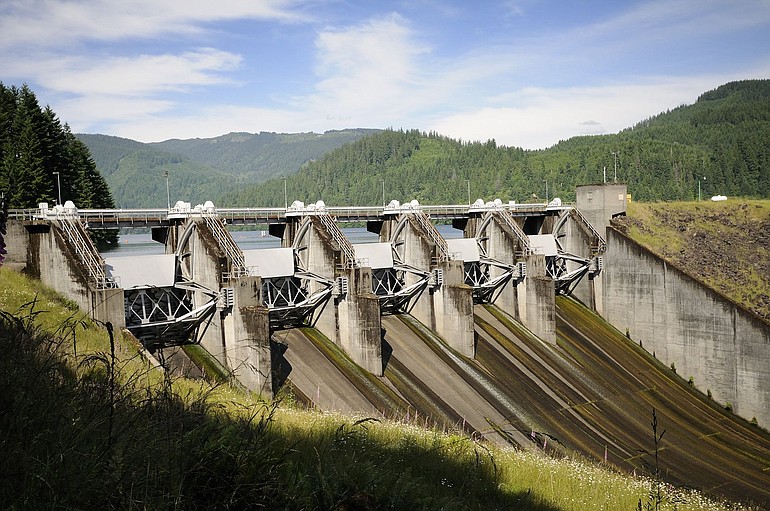Federal energy regulators are raising alarm about the potential for “catastrophic failure” of spillway gates on three major PacifiCorp-owned dams on the North Fork of the Lewis River.
The concern arises from a 10-year inspection earlier this year by the investor-owned utility that was submitted to the Federal Energy Regulatory Commission in late January. PacifiCorp and the federal agency declined to release the report itself, citing security concerns.
However, it did elicit a strong reaction from federal regulators.
In a letter dated June 2, FERC Regional Engineer Patrick J. Regan summarized a series of concerns with the report’s findings, including missing or broken bolts and rivets, out-of-plane bending and cracked welds.
“Some of these findings seem a cause for great concern,” Regan wrote in a letter addressed to PacifiCorp Energy official Randy A. Landolt in Portland. “For instance, at Merwin, loss of enough rivets or bolts near a trunnion could cause a catastrophic failure of the gate.”
Emergency managers in Clark and Cowlitz counties, alerted to the findings by The Columbian, said they are satisfied with PacifiCorp’s management of the dams and have been assured by the utility that the collapse of a spillway gate — called a tainter gate — shouldn’t create a major problem downriver.
“We are not concerned,” Cheryl Bledsoe, Clark County emergency manager, wrote in an e-mail Wednesday. “At ‘full catastrophic failure’ of that tainter gate, we are told that it would result in a spillage of 26,000 cubic feet per second. In our local flood response planning, this results in a courtesy call to one home in Woodland who might have some horses at risk.”
A PacifiCorp spokeswoman called the inspection “routine,” and that the company plans to fix the problems within six months to a year.
“We share FERC’s interest in making sure the spillway gates and the entirety of our hydro facilities are safe, operational and performing properly,” said Jan Mitchell, a company spokeswoman in Portland. “We believe that’s the current status.”
Yet federal regulators said they view the report’s findings as going beyond typical wear and tear.
“We requested additional information from PacifiCorp so we could fully understand the situation,” said Celeste Miller, a FERC spokeswoman in Washington, D.C. “They have provided that information, and we’re currently reviewing it.”
Agency officials said they wouldn’t expect the sudden loss of a spillway gate to cause major flooding beyond the river’s channel. However, they said the uncontrolled release of water could create unanticipated problems for fishermen or other recreationists downstream.
Further, the spillway gates enable dam operators to manipulate the water volume of the enormous reservoirs backing up against each dam. If even one gate failed or became stuck in an open position, federal officials said, it could compromise the dam’s ability to corral floodwater. If a gate jammed shut, water surging across the top of the stuck gate could cause a more serious safety issue affecting the structure of the dam itself, according to FERC officials.
The gates are located at the top of each dam at the head of a spillway.
Merwin Dam, which rises 93 feet above its spillway, has five separate gates 35 feet high. Yale has five spillway gates, and Swift Dam has two. In each case, the gates are raised and lowered with triangular arms extending back to a pivot point known as a trunnion.
The condition of many of these gates is described as “poor” in the June 2 letter authored by FERC’s regional engineer in Portland.
The letter, which FERC has subsequently removed from the agency’s publicly accessible website, got the attention of Cougar-area resident Mike Hayden. Hayden, an off-road enthusiast and retired Camas paper mill employee, said he began tracking FERC’s correspondence over the North Fork dams after getting involved with recreation-related issues around the reservoirs.
“They put those dams in there … and that’s fine,” said Hayden, who forwarded the letter to The Columbian. “But just take care of them.”
Merwin began generating electricity in 1931, Yale in 1953, and Swift was completed in 1958. The federal government renewed the dams’ operating licenses in 2008 after a years-long settlement process involving government and community groups.
Noel Johnson, a Woodland-area resident who served as an at-large citizen in the settlement negotiations, said he was stunned by FERC’s description of the condition of the spillway gates.
“It’s just unbelievable,” he said.
Grover Laseke, a former Woodland city police chief who now serves as Cowlitz County’s emergency manager, said he trusts PacifiCorp’s assertion that there is no cause for concern.
“When I talked to the folks there, they assured me the gates are OK,” he said. “They feel that it’s nothing more than a maintenance issue.”
Erik Robinson: 360-735-4551, or erik.robinson@columbian.com.




